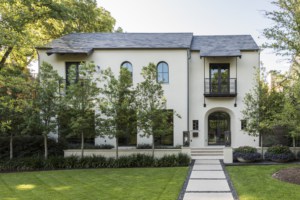In landscape design, incorporating trees offers numerous benefits beyond just aesthetic appeal. Here are some of the advantages of having trees in your landscape design, followed by a list of Texas-friendly trees.
Benefits of Trees in Landscape Design:
Aesthetic Enhancement: Trees add beauty and visual interest to your landscape design. They provide structure, texture, and color that enhance the overall appeal of your outdoor space.
Shade and Cooling: Trees provide shade, which helps to cool outdoor areas during hot Texas summers. Strategically planted trees can reduce the need for air conditioning, thus saving energy and lowering utility bills.
Windbreaks and Privacy: Trees act as natural windbreaks, reducing wind speeds and creating a more comfortable outdoor environment. They also provide privacy by screening views from neighboring properties or busy streets.
Air Quality Improvement: Trees absorb carbon dioxide and other pollutants while releasing oxygen, thereby improving air quality. They also trap dust and particulate matter, making the air cleaner and healthier for humans and wildlife.
Habitat for Wildlife: Trees provide habitat and food sources for birds, insects, and other wildlife. They contribute to biodiversity and support ecosystem health in your garden or yard.
Soil Erosion Control: The roots of trees help to stabilize soil, reducing erosion and preventing sediment runoff. This is particularly beneficial in areas prone to erosion, such as along riverbanks or slopes.
Noise Reduction: Trees can act as natural sound barriers, absorbing and deflecting sound waves, thus reducing noise pollution from nearby roads or urban activities.
Property Value: Well-landscaped properties with mature trees are often more valuable than those without. Trees enhance curb appeal and can increase property values by providing a sense of maturity and permanence.


List of Texas-Friendly Trees:
Live Oak: A classic Texas tree known for its large spreading canopy and drought tolerance.
Texas Redbud: A small ornamental tree with showy pink flowers that bloom in early spring.
Lacey Oak: A smaller oak tree native to Texas with attractive blue-green foliage and good drought tolerance.
Texas Mountain Laurel: A slow-growing evergreen tree with fragrant purple flowers in spring and glossy green foliage.
Cedar Elm: A tough and adaptable native tree with small, serrated leaves and good drought tolerance.
Pecan: A large shade tree prized for its delicious nuts and attractive foliage, well-suited to the Texas climate.
Texas Ash: A fast-growing tree with bright green foliage and good tolerance to heat and drought.
Chinquapin Oak: A medium to large-sized oak tree with distinctive shiny, dark green leaves and excellent drought tolerance.
When selecting trees for your landscape design in Texas, consider factors such as soil type, sun exposure, water availability, and space constraints to ensure successful growth and long-term enjoyment of your outdoor space. Looking to create your outdoor oasis? Contact us today!